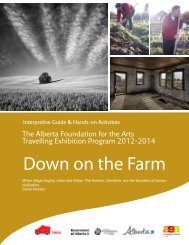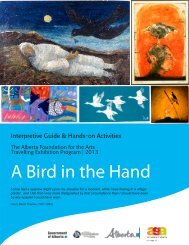Urban Animals - Art Gallery of Alberta
Urban Animals - Art Gallery of Alberta
Urban Animals - Art Gallery of Alberta
Create successful ePaper yourself
Turn your PDF publications into a flip-book with our unique Google optimized e-Paper software.
The <strong>Alberta</strong> Foundation for the <strong>Art</strong>s Travelling Exhibition Program<br />
Animal Facts: Wolf continued<br />
Wolves are territorial animals. The average<br />
size <strong>of</strong> a wolf pack’s territory is close to 200<br />
square kilometers. Wolf packs travel constantly<br />
in search <strong>of</strong> prey. The core <strong>of</strong> their territory is,<br />
on average, 35 square kilometers, in which they<br />
spend 50% <strong>of</strong> their time. Wolves tend to avoid<br />
hunting in the fringes <strong>of</strong> their territory, even<br />
though prey density tends to be higher there,<br />
due to the possibility <strong>of</strong> fatal encounters with<br />
neighbouring packs.<br />
Wolves feed primarily on medium to large<br />
sized ungulates. However, like most predators,<br />
they are opportunistic feeders and will<br />
http://en.wikipedia.org/wiki/Wolf<br />
generally eat any meat that is available. Wolf<br />
packs above 2 individuals show little strategic<br />
cooperation in hunting large prey. Wolves typically attempt to conceal themselves as they<br />
approach their prey. If the prey animal stands its ground or confronts the pack the wolves will<br />
approach and threaten it but eventually leave if their prey does not run. Usually it is the<br />
dominant pair in a pack that works the hardest in killing the pack’s prey. During feeding this<br />
status is reinforced. The breeding pair usually eats first. Wolves <strong>of</strong> intermediate rank will prevent<br />
lower ranking pack members from feeding until the dominant pair finishes eating. Wolves<br />
supplement their diet with vegetation and, after eating, will drink large quantities <strong>of</strong> water to<br />
prevent uremic poisoning.<br />
Wolves communicate with each other in a variety <strong>of</strong> ways. They can communicate visually<br />
through a variety <strong>of</strong> expressions and moods ranging from subtle signals, such as a slight shift in<br />
weight, to more obvious ones, such as rolling on their backs to indicate complete submission.<br />
Howling is also extremely important. Howling helps pack members keep in touch, allowing them<br />
to communicate effectively in thickly forested areas or over great distances. Howling also helps<br />
to call pack members to a specific location and serves as a declaration <strong>of</strong> territory. Wolves will<br />
also howl for communal reasons. Some scientists speculate that such group sessions<br />
strengthen the wolves’ social bonds and camaraderie. Observations <strong>of</strong> wolf packs suggest that<br />
howling occurs most <strong>of</strong>ten during the twilight hours, preceding the adults’ departure for or return<br />
from a hunt. Wolves also howl more frequently during the breeding season and rearing process.<br />
A wolf’s howl may be heard from up to 16 kilometers (10 miles) away depending on weather<br />
conditions.<br />
Humans have had a complex and varied viewpoint <strong>of</strong> wolves. In many parts <strong>of</strong> the world<br />
and in many cultures wolves were respected and revered whereas in others they have been<br />
feared and held in distaste. Humans dislike <strong>of</strong> wolves has resulted in a great reduction in the<br />
wolfs’ former range and, from 1982 to 1994, the gray wolf was listed as vulnerable to extinction<br />
by the International Union for Conservation <strong>of</strong> Nature. Changes in legal protections, land-use<br />
and population shifts to urban areas, and recolonization and reintroduction programs have<br />
increased wolf populations in western Europe and the western United States. As a result, the<br />
risk status <strong>of</strong> the wolf has been reduced to being <strong>of</strong> least concern.<br />
AFA Travelling Exhibition Program, Edmonton, AB. Ph: 780.428.3830 Fax: 780.421.0479<br />
youraga.ca

















